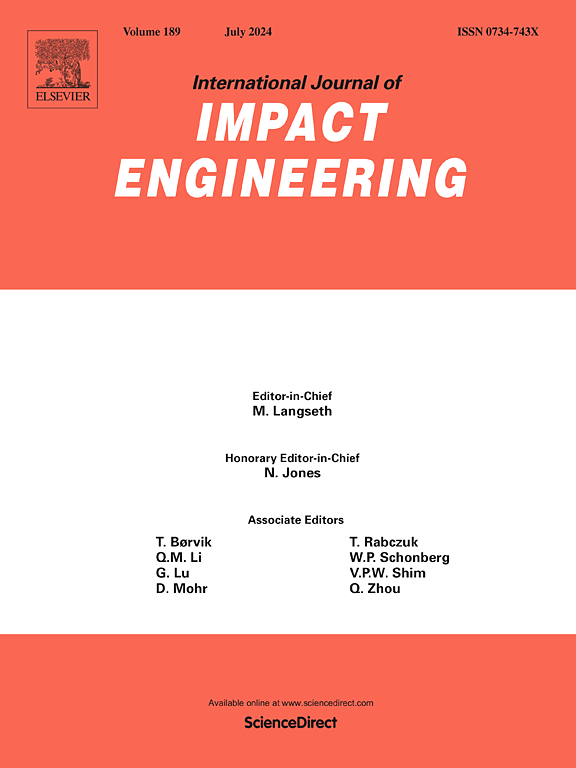Regularization of softening plasticity models for explicit dynamics using a gradient-enhanced modified Johnson–Holmquist model
IF 5.1
2区 工程技术
Q1 ENGINEERING, MECHANICAL
International Journal of Impact Engineering
Pub Date : 2024-12-24
DOI:10.1016/j.ijimpeng.2024.105209
引用次数: 0
Abstract
The behavior of concrete under high strain rates is often described by plasticity models with softening, which is modeled by a reduction of the yield surface as a function of the local equivalent plastic strain. Many of these models are local and therefore produce mesh-dependent results. In this contribution, the gradient-enhancement of such models is investigated to mitigate the mesh-dependency.
First, the mesh-dependency of these local formulations based on the analysis with a modified JH2 model as a representative for these constitutive formulations is demonstrated using a one-dimensional benchmark example. In the benchmark, the width of the damaged zone decreases upon mesh-refinement and the dissipated plastic energy tends to zero. It is further shown that a significantly small safety factor for the critical time step is needed in order to achieve accurate results for the benchmark example.
The first investigated gradient-enhancement approach replaces the equivalent local plastic strain with its nonlocal counterpart. The enhancement is based on the inclusion of inertia and damping to the additional Helmholtz equation which enables the use of the central difference method as an explicit solver. This method successfully distributes the damage over several elements, however, the local equivalent plastic strain still localizes into one cell. The inclusion of hardening with respect to the local equivalent plastic strain inhibits the localization and the dissipated plastic energy converges with mesh-refinement.
This is further confirmed in a two-dimensional wedge-splitting experiment and a four-point bending test where the damage pattern produced by the local model is mesh-dependent as well and the dissipated plastic energy tends to zero with mesh-refinement. The proposed nonlocal model with hardening results in a consistent damage pattern and the dissipated plastic energy converges. Furthermore, the nonlocal model with hardening is less sensitive to time step refinement, such that computational efficiency can be improved compared to the local model.
The numerical experiments are implemented using the free open source tool FEniCSx and have been made available on Zenodo.
求助全文
约1分钟内获得全文
求助全文
来源期刊

International Journal of Impact Engineering
工程技术-工程:机械
CiteScore
8.70
自引率
13.70%
发文量
241
审稿时长
52 days
期刊介绍:
The International Journal of Impact Engineering, established in 1983 publishes original research findings related to the response of structures, components and materials subjected to impact, blast and high-rate loading. Areas relevant to the journal encompass the following general topics and those associated with them:
-Behaviour and failure of structures and materials under impact and blast loading
-Systems for protection and absorption of impact and blast loading
-Terminal ballistics
-Dynamic behaviour and failure of materials including plasticity and fracture
-Stress waves
-Structural crashworthiness
-High-rate mechanical and forming processes
-Impact, blast and high-rate loading/measurement techniques and their applications
 求助内容:
求助内容: 应助结果提醒方式:
应助结果提醒方式:


